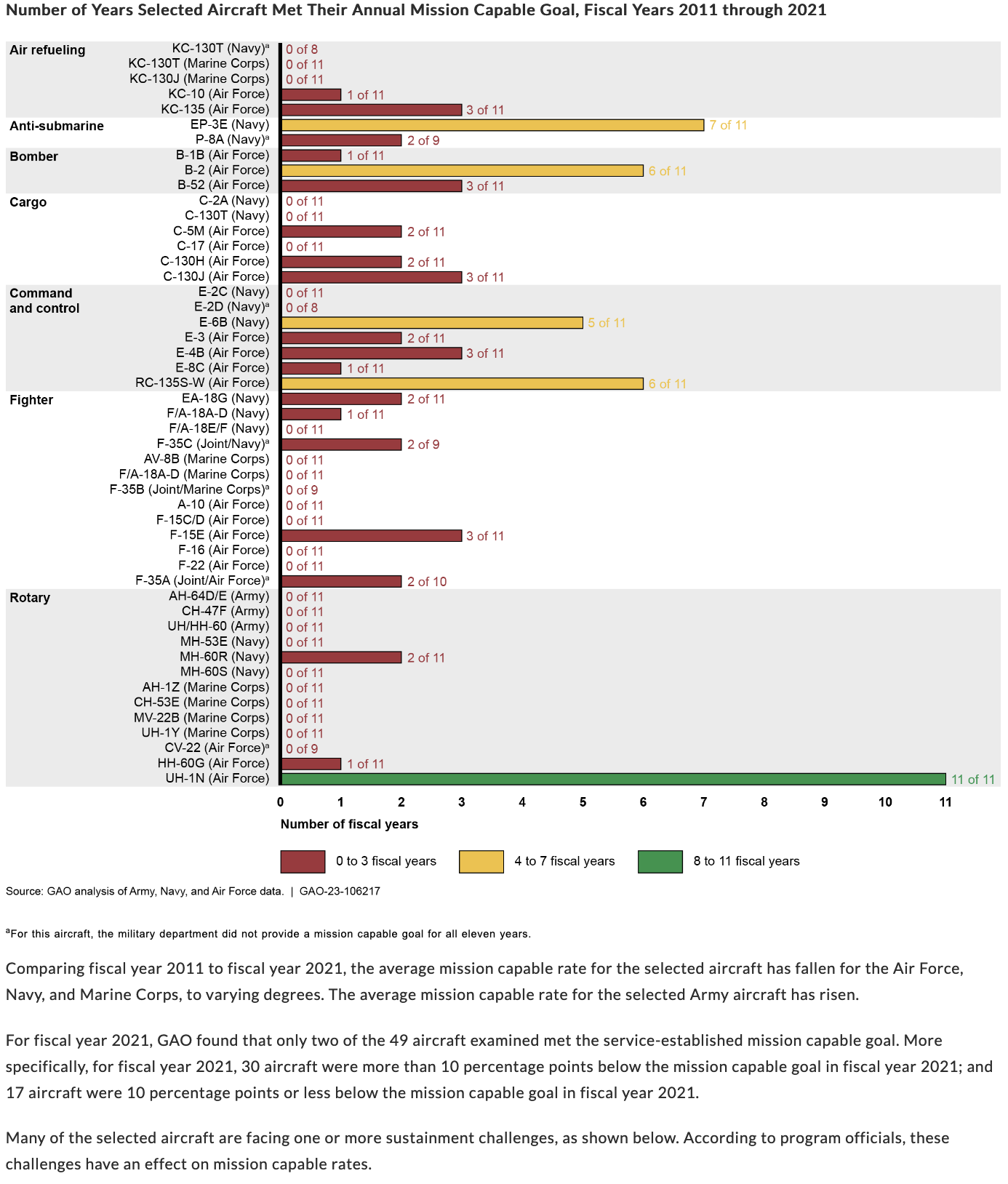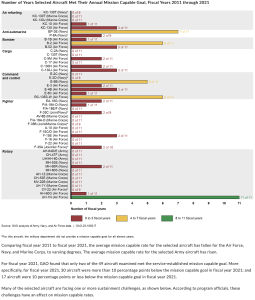by Alex Christoforou, The Duran:

Here is from the opening of the 10 November 2022 U.S. General Accounting Office study, “Weapon System Sustainment: Aircraft Mission Capable Goals Were Generally Not Met and Sustainment Costs Varied by Aircraft”, report # GAO-23-106217:
We looked at 49 types of military aircraft and found that only 4 types met their annual mission readiness goals from FY 2011 through FY 2021 — an overall decline over time. Program officials gave us various reasons for these results, including aging aircraft, maintenance challenges, and issues with getting parts and supplies. …
TRUTH LIVES on at https://sgtreport.tv/
As shown below, 26 aircraft did not meet their annual mission capable goal in any fiscal year [it scored 0 in each and every goal in each and every year]. The mission capable rate — the percentage of total time when the aircraft can fly and perform at least one mission — is used to assess the health and readiness of an aircraft fleet.

[Note that “*For this aircraft [7 aircrafts], the military department did not provide a mission capable goal for all eleven years.” The study also says “The mission capable rate — the percentage of total time when the aircraft can fly and perform at least one mission — is used to assess the health and readiness of an aircraft fleet.” For those 7 aircraft-types, the U.S. Department of Defense refused to provide data to calculate “the percentage of total time when the aircraft can fly and perform at least one mission.” Only 3 of those 7 aircraft-types showed more than 0 years in which some years’ data (2 years in each instance) when “Their Annual Mission Capable Goal” had been met: the P-8A Anti-submarine, and the F-35C and F-35A Fighters; but the F-35B Fighter was instead among the 26 aircraft-types that constantly failed its “Annual Mission Capable Goal.”]
Comparing fiscal year 2011 to fiscal year 2021, the average mission capable rate for the selected aircraft has fallen for the Air Force, Navy, and Marine Corps, to varying degrees. The average mission capable rate for the selected Army aircraft has risen.
For fiscal year 2021, GAO found that only two of the 49 aircraft examined met the service-established mission capable goal. More specifically, for fiscal year 2021, 30 aircraft were more than 10 percentage points below the mission capable goal in fiscal year 2021; and 17 aircraft were 10 percentage points or less below the mission capable goal in fiscal year 2021.
Many of the selected aircraft are facing one or more sustainment challenges, as shown below. According to program officials, these challenges have an effect on mission capable rates.
Sustainment Challenges Affecting Some of the Selected Department of Defense Aircraft
Operating and support (O&S) costs totaled about $54 billion in fiscal year 2020 for the reviewed aircraft—a decrease of about $2.9 billion since fiscal year 2011 after factoring in inflation using constant fiscal year 2020 dollars. Maintenance costs became a larger portion of O&S costs—increasing by $1.2 billion since fiscal year 2011. Air Force and Army O&S costs have decreased, while Navy and Marine Corps O&S costs have increased. Based on our analysis and information provided by the program offices, these trends have largely been driven by changes in the size of aircraft inventory and reduced flying hours. Additionally, O&S costs have varied widely across aircraft fleets. For example, the total fiscal year 2020 O&S costs for the systems we reviewed ranged from [a low of] about $97 million for the KC-130T fleet (Navy and Marine Corps) to a high of about $4.3 billion for the F-16 fleet (Air Force). Based on our analysis and information provided by the system program offices, cost variances were based on aircraft type and factors such as age of the fleet, the number of aircraft included in the inventory, and the number of flying hours flown by a fleet.
Why GAO Did This Study
The Department of Defense (DOD) spends tens of billions of dollars annually to sustain its weapon systems in an effort to ensure that these systems are available to simultaneously support today’s military operations and maintain the capability to meet future defense requirements. This report provides observations on mission capable rates and costs to operate and sustain 49 fixed- and rotary-wing aircraft in the Army, Navy, Marine Corps, and Air Force.
GAO initiated this work in response to continuing interest in the operational availability and O&S costs for major weapon systems. We also initiated this work as part of our response to a provision in section 802 of the William M. (Mac) Thornberry National Defense Authorization Act for Fiscal Year 2021 for GAO to report on sustainment reviews conducted by the military services, with a specific focus on O&S cost growth. In addition to this report, GAO plans to issue additional reports in response to the provision. GAO reviewed documentation and interviewed program office officials to identify reasons for the trends in mission capability rates and O&S costs as well as any challenges in sustaining the aircraft.



